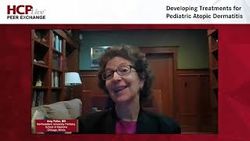Optimizing Treatment of Pediatric Atopic Dermatitis - Episode 11
First-Line Biologics for Pediatric AD and Psoriasis
Transcript:
Lawrence Eichenfield, MD: Let's move over to perspectives on our newer medications. The first question I'm going to ask is, do we think biologics should be in the first line to assure management in patients with pediatric AD [atopic dermatitis]? And how comfortable are we with the long-term safety and efficacy of biologics?
Fred Ghali, MD: I would say for most of our mild to moderate patients, first-line therapy is usually going to still begin with basic skincare. It's going to be with the use of topical steroids.
For the moderate to severe patients who are not responding to the traditional topical therapies, we're faced with the decision, are we going to move to systemic immunosuppressants? We’ve discussed some of the risks and benefits of those immunosuppressants. For me, I always have to approach atopic dermatitis as a chronic disease, so I need a long-term treatment for a chronic disease, and I think that's where the biologics are becoming my first second-line therapy, if you want to phrase it that way, for those patients.
I think it's important to look at the risks and benefits. You asked about safety for how long. That's the question we're getting in our clinic, is if we're using biologics, not only for AD but for psoriasis, how long do you go? And sometimes it's indefinitely. It depends how long the disease is. Oftentimes patients want to lengthen the interval between therapies or they may want to stop and restart, and that has its own concerns. But based upon the safety data for biologics, specifically with dupilumab, and from what I’ve experienced since 2017 in my own clinic, real world, I do feel comfortable with these agents for the long term.
Lawrence Eichenfield, MD: Let's say I have now a 19-year-old who's been on dupilumab for 2 years. So we're finishing the 2-year anniversary, and the question comes up, are you going to keep going or do we want to try to take a break? How do you guys handle that?
Elaine Siegfried, MD: I've had several patients who have interruptions in therapy for a variety of reasons, and I have had a few whose therapy was interrupted when their skin was clear and their disease has not come back in 6 months to a year. I've had others for whom it comes back, and I think that the data support this, that you can increase the interval between their treatments, between their doses. But the one risk that we don't have good data on is how that impacts long-term development of antidrug antibodies. It's still an unknown that's going to take us a while to sort that one out, but that's how I'm handling it.
Lawrence Eichenfield, MD: I should be clear that we are talking off-label here.
Elaine Siegfried, MD: Definitely.
Lawrence Eichenfield, MD: But we're talking off-label master's class, the issues that we actually face. And I think there are data sets that argue that, the dupilumab study showed when people rolled over to Q4 [every 4] or Q8 [every 8] week dosing, what happened. And it's a population effect, just like taking patients off oral antibiotics and topical retinoids for acne. There are a lot of patients, 75% can go 9 months to a year, great, continuing the gains they had; and 25% don't. I do think we'll be testing that. But right now, I think the advantage is that we have accumulated safety data that first come from the adults, then we add the adolescents to it, now we'll add the kids, with the ones in trials first and then in real-life use. But nothing has popped up yet with our first targeted biologic that makes us more concerned about long-term safety compared to some other biologics in other fields.
Transcript Edited for Clarity



